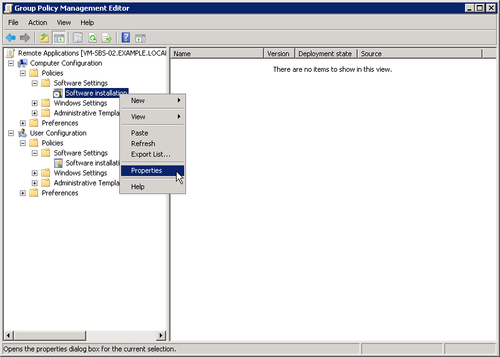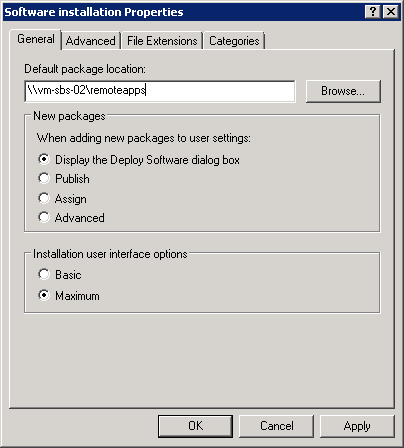4. Configuring the Group Policy Software Installation
Extension
A number of options control how Group Policy deploys and
manages software packages. These options determine how packages are
added to the GPO, the amount of control users have over an
installation, and the default application for a given file
extension, as well as which categories you can use for grouping
applications. The following sections cover these options.
Note:
Software installation settings for applications deployed to users are not shared
with applications that are deployed to computers. Each type of
deployment maintains its own set of applications and
settings.
4.1. Setting Software Installation Options
To change the default settings for the Group Policy Software
Installation extension, first open the Software Installation
Properties dialog box by performing the following steps:
Open the Group Policy Management Console from the
Administrative Tools menu.
Right-click the GPO you created for application
deployment and select Edit.
Under Computer Configuration or User Configuration,
expand Policies and then expand Software Settings.
Right-click Software Installation and select Properties,
as shown in Figure 3, to open
the Software Installation Properties dialog box.

Note:
Software Installation settings for applications deployed to users are not
shared with applications that are deployed to computers.
Each type of deployment maintains its own set of
applications and settings.
On the General tab (shown in Figure 4),
specify the location of the software distribution
point.

In the New Packages area, specify the default behavior
for new software packages. Table 1 shows
the choices.
In the Installation User Interface Options area, choose
Basic for limited visibility to the user of the installation
process; choose Maximum for full visibility during
installation.
Table 1. Default behavior options when adding new
packages
| OPTION | WHAT IT DOES |
|---|
| Display The Deploy Software Dialog
Box | Displays a dialog box asking whether to
publish (User Configuration only) or assign the
application, or whether to customize the
configuration |
| Publish (User Configuration
Only) | Automatically publishes the application
using default settings |
| Assign | Automatically assigns the application
using default settings |
| Advanced | Displays the application’s advanced
properties, allowing a customized
installation |
Click the Advanced tab to set additional options for the
software packages under this GPO:
To uninstall applications automatically when the GPO
no longer applies to the user or computer, select
Uninstall The Applications When They Fall Out Of The Scope
Of Management.
To add OLE information as part of the application
deployment, select Include OLE Information When Deploying Applications.
To allow standard .MSI applications to be deployed
to 64-bit computers, select Make 32-Bit X86 Windows
Installer Applications Available To Win64 Machines. (This
is the default behavior.)
To allow legacy 32-bit applications (ZAP files) to
be deployed to 64-bit computers, select Make 32-Bit X86
Down-level (ZAP) Applications Available To Win64
Machines.
To set up a list of software categories, thereby making
it easier for users to find the applications they want, click
the Categories tab, click Add, and type the category name.
Categories apply to the entire domain, not just the current
GPO. Click OK when finished.
Note:
The File Extensions tab will be empty when you first
create a new GPO because Windows lists only file extensions
associated with packages already present in the GPO. Later you
can return to this tab to select the order in which file
extensions should be recognized.